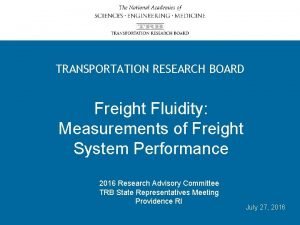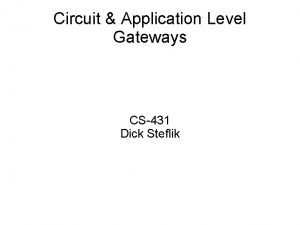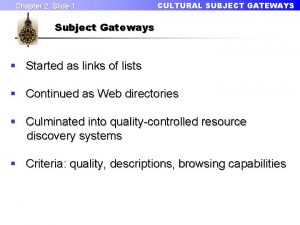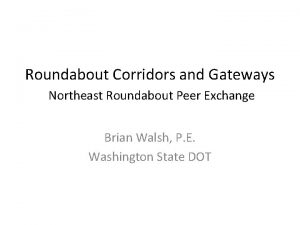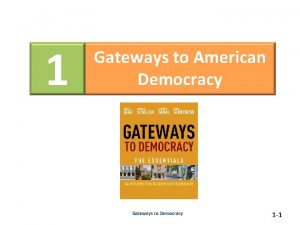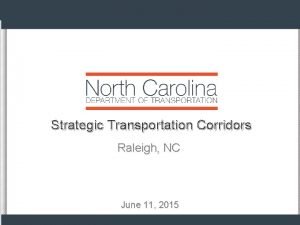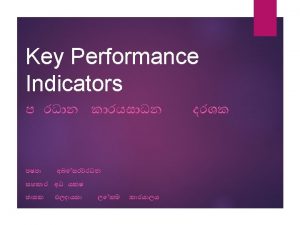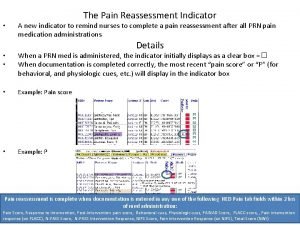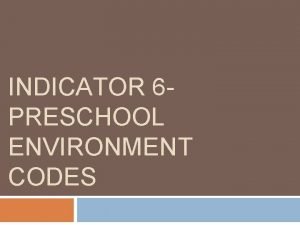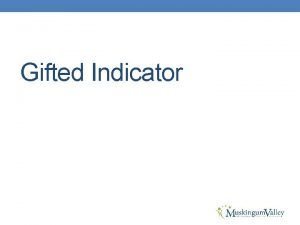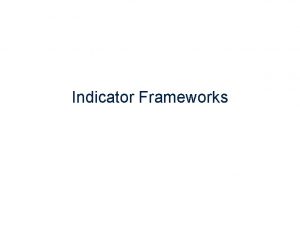Gateways Trade Corridors FLUIDITY INDICATOR June 2014 Fluidity


















- Slides: 18

Gateways & Trade Corridors FLUIDITY INDICATOR June 2014

Fluidity Indicator • Tracking the performance of strategic freight routes provides governments and stakeholders impartial evidence-based results on the competitiveness of Canada’s supply chains • The Fluidity indicator is a web-based multi-modal tool that measures in near real-time the performance of individual segments of the supply chains as well as the end-to-end transit time of freight flows • The metric is focusing on bottlenecks and impediments along major trade corridors; with a special attention given to port infrastructure • Transport Canada’s fluidity indicator is an interactive tool in the context of the North American marketplace. Transport Canada - Economic Analysis & Research 2

Phase 1: IMPORT SUPPLY CHAIN Economic Analysis Directorate Transport Canada - Economic Analysis & Research 3

CORRIDORS IMPORT: ASIA-PACIFIC PRINCE RUPERT • • Hong Kong Shanghai Qingdao Tokyo VANCOUVER Calgary Winnipeg Toronto Montreal Chicago PHASE 2 CORRIDORS: CONTINENTAL Toronto MONTREAL Chicago • Antwerp • Valencia Economic Analysis Directorate Transport Canada - Economic Analysis & Research 4

Reliability/Variability Total Transit Time from Shanghai to Toronto via Port Metro Vancouver 2010 -2013 Year Marine Mean Marine 95 th Port Mean Port 95 th Inland Mean Inland 95 th 2010 14. 2 16. 3 3. 1 7 5. 7 7. 6 23. 1 - 2011 15. 1 18. 2 2. 5 5. 8 5. 9 7. 7 23. 4 1. 2% 2012 15. 8 20. 2 2. 6 6 6. 1 8. 4 24. 5 4. 9% 2013 15. 6 19. 9 3 6. 8 6. 3 8. 4 24. 9 1. 4% Marine Port 2010 Inland Port 2011 Inland 61, 6 % *Totals may not add due to rounding 10, 5 % Marine Port 2012 Inland 24, 7 % 25, 1 % 24, 9 % 13, 0 % Marine 64, 4 % 10, 8 % Transport Canada - Economic Analysis & Research Total % Transit Change Marine Port 2013 Inland 25, 2% 64, 0 % 12, 2% 62, 6% 5

ALIGNING PERFORMANCE and RESILIENCY Economic Analysis Directorate 6

Port Utilization Indicators Monthly Intermodal Indicators (5 partner ports) 1. 2. 3. 4. 5. 6. 7. 8. 9. 10. 11. 12. Average Truck Turnaround Time Berth Utilization Average Vessel Turnaround Time Average Container Dwell Time Dwell Target - % under 72 Hours Port Productivity Vessel On-Time Performance Crane Productivity Number of Vessel Calls Average TEU per Vessel Call Container Throughput [Min. ] [TEU/meter of workable berth] [Sec. /TEU] [Hours] [Days] [%] [TEU/Gross Ha] [%] [Lifts per hour] [Number/month]

Government’s role Using Customs data for better planning Canada Border Security Agency Raw data collection Prior to departure Transport Canada (Data transformation and distribution) Port Authority (Recipient of “cleaned” data) Terminal Operators (Data Consumers) Transport Canada - Economic Analysis & Research Rail Carriers (Data Consumers) 8

Quantify immediate and residual impacts of disruptions on the rail network such as strikes and/or weather events. 10, 0 Days of Transit 8, 0 2012 Weekly Rail Transit time: PMV to Various Destinations 9 -day strike: May 23, 2012, Week 20 Residual effects Trend 6, 0 Destination 1 4, 0 2, 0 Destination 2 Return to Normal: Week 28 2012_01 2012_02 2012_03 2012_04 2012_05 2012_06 2012_07 2012_08 2012_09 2012_10 2012_11 2012_12 2012_13 2012_14 2012_15 2012_16 2012_17 2012_18 2012_19 2012_20 2012_21 2012_22 2012_23 2012_24 2012_25 2012_26 2012_27 2012_28 2012_29 2012_30 2012_31 2012_32 2012_33 2012_34 2012_35 2012_36 2012_37 2012_38 2012_39 2012_40 2012_41 2012_42 2012_43 2012_44 2012_45 2012_46 2012_47 2012_48 2012_49 2012_50 2012_51 2012_52 0, 0 Week of the Year Source: Transport Canada Fluidity database. Please note the data presented is an aggregate of both class 1 rail carriers. Transport Canada - Economic Analysis & Research 9

Quantify immediate and residual impacts of disruptions on the rail network such as strikes and/or weather events. Source: Transport Canada Fluidity database. Please note the data presented is an aggregate of both class 1 rail carriers. Transport Canada - Economic Analysis & Research 10

Phase 2: EXPORT SUPPLY CHAIN Economic Analysis Directorate Transport Canada - Economic Analysis & Research 11

Export Side Challenging for supply chain measurement Unit of measurement is a challenge Identification of commodities Ø Ø Ø Grains , forest products, Iron ore and coal Estimating border wait times becomes relevant for our exports Narrowing the focus: Critical Infrastructure for strategic commodities Transport Canada - Economic Analysis & Research 12

CORRIDORS GRAINS EXPORT: CANADA-ASIA Japan Marine Terminals Western Canada Port Metro Vancouver (PMV) Ocean Transit Times Prince Rupert Economic Analysis Directorate Transport Canada - Economic Analysis & Research Rail Transit Times Alberta Saskatchewan Manitoba 13

Geospatial Analysis of Southbound Truck Border Wait Times at Peace Bridge/Fort Erie Crossing Ø Border wait times are defined as the elapsed time from the last geospatial observation before a trip enters the geofence to first observation when a trip exits the geofence Ø Trucks with wait times above 90 minutes are assumed to have been sent to secondary inspection and removed from the sample Ø Trips where the time difference between the last geospatial observation before entering the geofence and the first one inside is greater than 15 minutes are removed from the sample 14

Transport Canada - Economic Analysis & Research 15

• The fluidity indicator is evidence-based information to assess and analyze the efficiency of our supply chains. • The project assists Transport Canada’s work on the identification of constraints in the transportation system. • Assist Canadian SMEs through the Canadian Manufacturers and Exporters Association’s Enterprise Project • Provide strategic information on the resilience of our supply chains by measuring the recovery rates after major disruptions. • It is a horizontal project serving other government departments and initiatives: – Department of Foreign Affairs and International Trade and Development – Public Safety: Critical Infrastructure – Provincial Government – British Columbia Transport Canada - Economic Analysis & Research 16

Fluidity Web Portal Here’s what you see when you login onto the Fluidity Web Portal application. Login procedures are provided by Transport Canada.

THANK YOU MERCI GRACIAS Economic Analysis Directorate 18
 Tent corridors
Tent corridors Safe corridors law
Safe corridors law Core network corridors
Core network corridors Flacs checkpoint b spanish exam june 2014 answers
Flacs checkpoint b spanish exam june 2014 answers Fluidity of gas
Fluidity of gas Fluidity operations llc
Fluidity operations llc Fluidity in a sentence
Fluidity in a sentence Office interface vs industrial interface
Office interface vs industrial interface Application level gateways
Application level gateways Gateways to art 2nd edition
Gateways to art 2nd edition Pstn
Pstn Circuit-level gateways
Circuit-level gateways Gateways to opportunity
Gateways to opportunity Protocol gateways
Protocol gateways Unified communication gateway
Unified communication gateway Examples of subject gateways
Examples of subject gateways Protocol gateways
Protocol gateways Behaviour management middleware
Behaviour management middleware Bpmn gateways
Bpmn gateways





